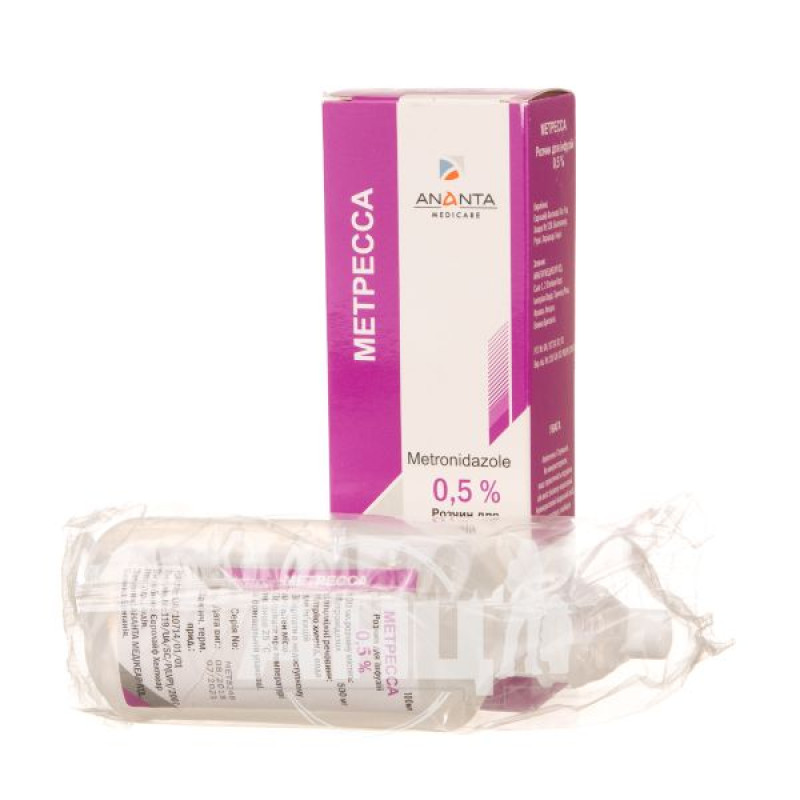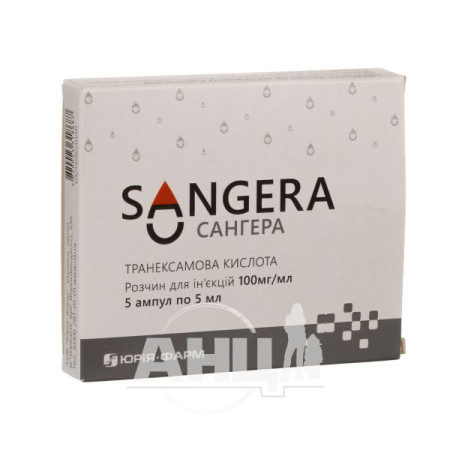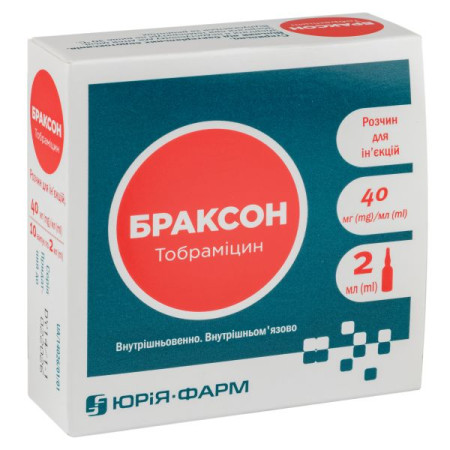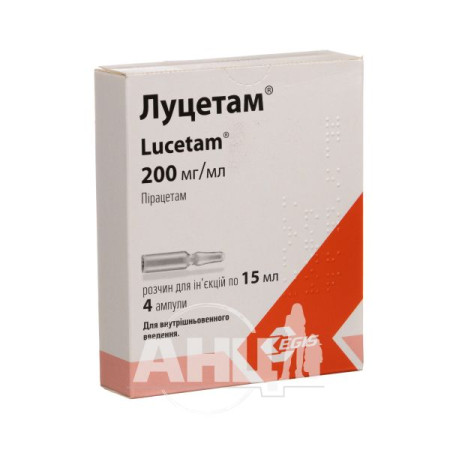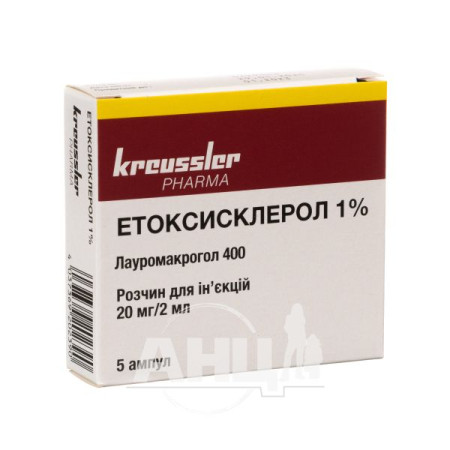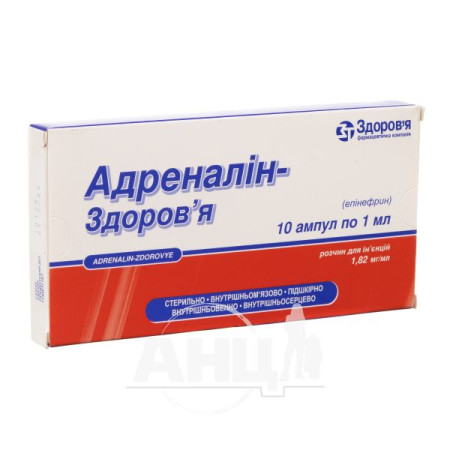Metressa solution for infusions 0.5% container 100 ml No. 1
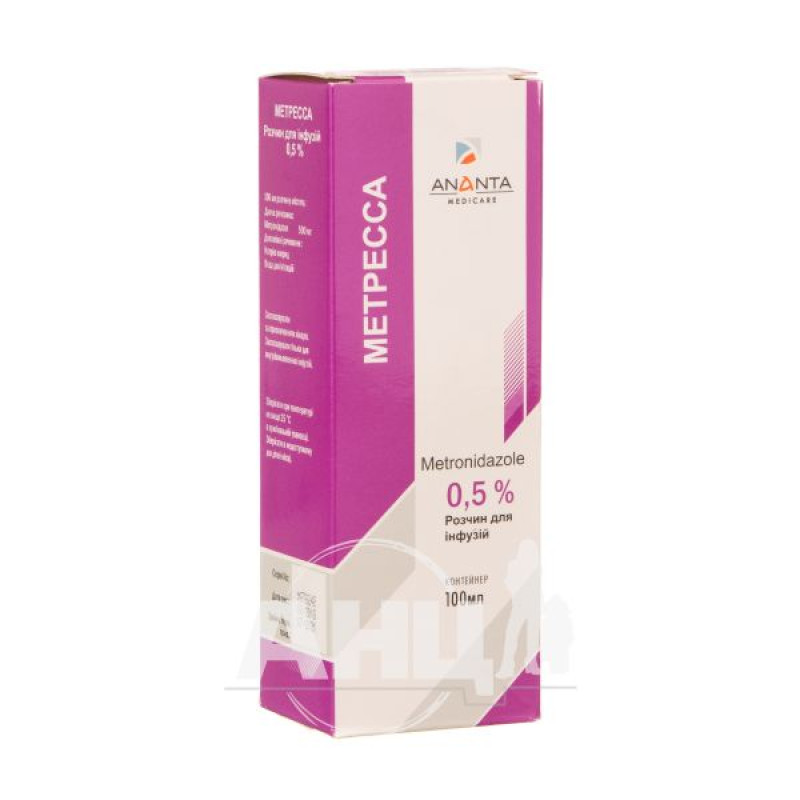
Instructions for Metressa solution for infusions 0.5% container 100 ml No. 1
Composition
active ingredient: metronidazole;
100 ml of solution contains 500 mg of metronidazole;
Excipients: sodium chloride, water for injections.
Dosage form
Solution for infusion.
Main physicochemical properties: transparent, colorless or pale yellow solution.
Pharmacotherapeutic group
Antibacterial agents for systemic use. Imidazole derivatives.
ATX code J01X D01.
Pharmacological properties
Pharmacodynamics.
The active ingredient of the drug - metronidazole - is a synthetic (derivative of 5-nitroimidazole), antiprotozoal and antibacterial agent. The mechanism of its action is the biochemical reduction of the 5-nitro group of metronidazole by intracellular transport proteins of anaerobic microorganisms and protozoa. The reduced 5-nitro group of metronidazole interacts with the DNA of microorganisms, inhibiting its synthesis, which leads to the death of microorganisms.
Metronidazole is effective against Trichomonas vaginalis, Giardia intestinalis, Gardnerella vaginalis, Entamoeba histolytica, Balantidium coli, Lamblia spp., as well as obligate anaerobes: Bacteroides spp. (B. fragilis, B. distasonis, B. thetaiotaomicron, B. vulgatus, B. ovatus), Fusobacterium spp., Veillonella spp., Prevotella spp. (P.bivia, P.buccae, P.disins) and some gram-positive microorganisms: Eubacterium spp., Clostridium spp., Peptostreptococcus spp., Peptococcus spp.
In combination with amoxicillin, metronidazole is active against Hilobacter pylori, as amoxicillin inhibits the development of resistance to metronidazole.
Aerobic microorganisms and facultative anaerobes are insensitive to metronidazole.
Pharmacokinetics.
After intravenous infusion of 500 mg of metronidazole (over 20 min) to patients with anaerobic infections, the concentration of the drug in the blood serum was 35.2 μg/ml after 1 hour, 33.9 μg/ml after 4 hours, and 25.7 μg/ml after 8 hours. The concentration of metronidazole in the bile of the gallbladder after intravenous infusion of 500 mg to patients with normal biliary tract function is significantly higher than in the blood serum. Metronidazole reaches bactericidal concentrations in most tissues and fluids of the human body, including the brain, cerebrospinal fluid, abscess cavities, saliva, bile, genital secretions, amniotic fluid, and breast milk.
In humans, 30-60% of metronidazole is metabolized by side-chain oxidation, hydroxylation, and glucuronidation. The main metabolic product is 1-(2-hydroxyethyl)-2-oxymethyl-5-nitroimidazole, which together with the glucuronide constitutes 40% to 50% of the substance excreted in the urine.
In patients with normal liver function, the half-life of metronidazole after a single dose is on average 8 hours (6-12 hours). In the case of alcohol-induced liver dysfunction, the half-life increases to 18 hours (10-29 hours).
Metronidazole is poorly bound to plasma proteins, not exceeding 10-20%. It readily penetrates tissues, and its volume of distribution is 70-95% of body weight.
Within 24 hours, from 35% to 65% of all nitro derivatives of the drug are excreted in the urine. Renal clearance is 10.2 ml/min. In patients with impaired renal function, accumulation of metronidazole in the blood serum is observed after repeated administration of the drug. Therefore, patients with acute renal failure are recommended to reduce the number of administrations of the drug.
Indication
Treatment and prevention of infections caused by microorganisms sensitive to metronidazole (mainly anaerobic bacteria).
Treatment is effective in cases of:
– central nervous system infections (including brain abscess, meningitis);
– infections of the lungs and pleura (including necrotizing pneumonia, aspiration pneumonia, lung abscess);
– endocarditis;
– infections of the gastrointestinal tract and abdominal cavity, including peritonitis, liver abscess, infections after operations on the colon or rectum, purulent lesions of the abdominal or pelvic cavity;
– gynecological infections (including endometritis after hysterectomy or cesarean section, puerperal fever, septic abortion);
– infections of ENT organs and oral cavity (including Simanovsky-Plaut-Vincent angina);
– bone and joint infections (including osteomyelitis);
– gas gangrene;
– septicemia with thrombophlebitis.
In mixed aerobic and anaerobic infections, appropriate antibiotics for the treatment of aerobic infections should be used in addition to Metressa.
Prophylactic use is always indicated before surgeries with a high risk of anaerobic infections (before gynecological and intra-abdominal surgeries).
When using metronidazole, national and international guidelines for the appropriate use of antimicrobials should be taken into account.
Contraindication
Hypersensitivity to metronidazole and other nitroimidazole derivatives. Organic lesions of the central nervous system (including epilepsy); blood diseases; liver failure (if it is necessary to prescribe high doses of the drug).
Interaction with other medicinal products and other types of interactions
Metressa should be prescribed with caution when treated with certain medications.
Drinking alcohol during treatment with the drug may lead to the development of adverse reactions such as flushing, tachycardia, dizziness and nausea (disulfiram-like effect).
Amiodarone.
QT prolongation and torsade de pointes have been reported with concomitant use of metronidazole and amiodarone. ECG monitoring of the QT interval may be appropriate when amiodarone is used in combination with metronidazole. Outpatients should be advised to seek medical attention if symptoms suggestive of torsade de pointes occur, such as dizziness, palpitations, or loss of consciousness.
Antibiotics and sulfonamides.
The antimicrobial effect of Metressa is enhanced in combination with antibiotics and sulfonamides.
Barbiturates.
Phenobarbital may enhance the hepatic metabolism of metronidazole, reducing its plasma half-life to 3 hours.
Busulfan.
Concomitant use of metronidazole may significantly increase the plasma concentration of busulfan. The mechanism of their interaction has not been described. Due to the potential risk of severe toxicity and fatal outcome associated with increased plasma levels of busulfan, its simultaneous use with metronidazole should be avoided.
Disulfiram (Esperal).
Concomitant use may cause confusion or even psychotic reactions. Combinations of these drugs should be avoided.
Carbamazepine.
Metronidazole may inhibit the metabolism of carbamazepine and consequently increase its plasma concentrations.
Contraceptives.
Some antibiotics may in isolated cases reduce the effectiveness of oral contraceptives by interfering with bacterial hydrolysis of steroid conjugates in the intestine and thus reducing the reabsorption of unconjugated steroids, resulting in reduced plasma levels of active steroids. This unusual interaction may be observed in women with high levels of biliary excretion of steroid conjugates. Cases of oral contraceptive failure have been reported with the use of various antibiotics, including ampicillin, amoxicillin, tetracyclines, and metronidazole.
Lithium.
In patients who have been treated with high doses of lithium for a sufficiently long time, concomitant administration of Metressa may increase the concentration of lithium in the blood plasma and develop symptoms of intoxication.
Mycophenolate mofetil.
Substances that alter the gastrointestinal flora (e.g. antibiotics) may reduce the oral bioavailability of mycophenolic acid preparations. Careful clinical and laboratory monitoring is recommended during therapy with anti-infective agents to detect a decrease in the immunosuppressive effect of mycophenolic acid.
Coumarin derivatives.
Metronidazole enhances the anticoagulant effect of coumarin derivatives, leading to an increase in prothrombin time and an increased risk of bleeding due to reduced hepatic degradation. Dosage adjustment of anticoagulants may be required.
Oral anticoagulant therapy: increased effects of oral anticoagulants and increased risk of hemorrhagic complications due to slower hepatic metabolism. More frequent monitoring of INR (international normalized ratio) levels is required. Adjustment of the oral anticoagulant dose is recommended during metronidazole administration and for 8 days after its discontinuation.
Special problems regarding the Ministry of Emergency Situations (international normalized ratio).
Many cases of increased activity of oral anticoagulants have been observed in patients treated with antibiotics. Risk factors may include infectious, inflammatory diseases and general health. It is difficult to determine the role of infectious pathology and its treatment in the incidence of MNS. However, some types of antibacterial agents require special attention. This applies to fluoroquinolones, macrolides, cyclines, cotrimazole and some cephalosporins.
Phenytoin: Metronidazole inhibits the metabolism of phenytoin when used concomitantly, i.e. plasma concentrations of phenytoin are reduced. On the other hand, the efficacy of metronidazole is reduced when used concomitantly with phenytoin.
Fluorouracil. Metronidazole inhibits the metabolism of fluorouracil when used simultaneously, i.e. plasma concentrations of fluorouracil increase.
Cyclosporine: There is a risk of increased serum cyclosporine concentrations when cyclosporine and metronidazole are used concomitantly. Frequent monitoring of cyclosporine and creatinine levels is necessary.
Cimetidine: Cimetidine inhibits the metabolism of metronidazole, which may lead to an increase in its serum concentration and an increased risk of adverse reactions.
Tacrolimus. Concomitant use of metronidazole may lead to increased blood concentrations of tacrolimus. The likely mechanism of inhibition of hepatic metabolism of tacrolimus is via CYP 3A4. Tacrolimus blood levels and renal function should be monitored frequently and the dosage adjusted accordingly, especially after the initiation of metronidazole withdrawal in patients stabilized on tacrolimus.
Impact on paraclinical tests.
It should be remembered that metronidazole is able to immobilize treponemas, which can lead to a false-positive Nelson test.
Application features
Do not remove the inner container from the wrapper until use. The outer wrapper protects the product from moisture. The inner container ensures the sterility of the product. After removing the outer wrapper, press the container to check for partial leakage of the product. If leakage occurs, the bottle should be replaced.
Immediately before use, the vial with the drug must be warmed to room temperature or, even better, to 37 ° C. For single use only. Discard unused residue.
The solution should only be used if it is clear and the container or packaging shows no visible signs of damage.
At the earliest opportunity, you should switch from intravenous infusions of Metressa to oral administration of the drug (200-400 mg 3 times a day).
While using the drug, you should not drink alcohol, as a disulfiram-like reaction may occur: abdominal pain of a spastic nature, nausea, vomiting, headache, hot flashes.
In patients with severe liver damage, impaired hematopoiesis (including granulocytopenia), metronidazole should be used only if the expected benefit outweighs the potential risk.
Since metronidazole is mainly metabolized in the liver, the clearance of metronidazole may be reduced in patients with impaired liver function. Significant accumulation of metronidazole may occur in patients with hepatic encephalopathy. As a result of increased plasma metronidazole concentrations, symptoms of encephalopathy may be exacerbated. If necessary, the daily dose may be reduced to 1/3 and taken once daily.
In renal failure, the half-life of metronidazole remains unchanged, so dose adjustment is not necessary. However, metronidazole metabolites are delayed in such patients. The clinical significance of this is unknown.
Metronidazole should be used with caution in patients with bone marrow or central nervous system diseases, as well as in elderly patients.
If there is a history of hematological disorders or in case of treatment with high doses of metronidazole and/or long-term use, regular monitoring of the white blood cell count is recommended.
If leukopenia develops, it is important to carefully weigh the expected benefits of continued treatment against the potential risks. In the case of long-term treatment, one should be monitored for the development of side effects such as central and peripheral neuropathy (paresthesia, ataxia, dizziness or convulsive crisis).
Metronidazole is not recommended for patients with porphyria.
Treatment with the drug should be discontinued if ataxia, dizziness, or confusion occurs.
It is important to remember the possible risk of worsening neurological status in patients with severe, chronic or active disorders of the central or peripheral nervous system.
Metronidazole is ineffective against aerobic and facultative anaerobic microorganisms.
With prolonged treatment (more than 10 days), blood tests and liver tests should be performed.
After treatment for Trichomonas vaginalis, the possibility of gonococcal infection remains.
Metronidazole and its metabolites are removed by hemodialysis within 8 hours. Therefore, patients should be re-administered metronidazole immediately after hemodialysis.
Metronidazole may cause false-negative results in serum aspartate aminotransferase levels.
During the course of treatment with metronidazole and for at least 3 days after its completion, patients should not drink alcoholic beverages due to the possible occurrence of reactions similar to the Antabuse syndrome (dizziness, vomiting).
Since metronidazole has been reported to be carcinogenic, long-term use of the drug is not recommended.
Special precautions regarding some components of the drug.
Patients on a controlled sodium diet should take into account that one dose of the drug contains 790 mg of sodium.
In the event of severe hypersensitivity reactions (including anaphylactic shock), treatment with metronidazole should be discontinued immediately and general emergency therapy should be initiated.
Severe persistent diarrhoea occurring during treatment or in the following weeks may be due to pseudomembranous colitis (in many cases caused by Clostridium difficile), see section "Adverse reactions". This intestinal disease caused by antibiotics can be life-threatening and requires immediate appropriate treatment. Drugs that inhibit peristalsis should not be taken.
The duration of treatment with metronidazole or other nitroimidazole-containing drugs should not exceed 10 days. Only in exceptional cases of urgent need, the treatment period may be extended, accompanied by appropriate clinical and laboratory monitoring. Repeated therapy should be limited to selected cases as much as possible. These restrictions should be strictly observed, since the possible mutagenic activity of metronidazole cannot be excluded, and also because of the increased incidence of certain tumors that has been observed in animal studies.
Impact on laboratory parameters
Metronidazole has high absorbance values at the wavelength at which nicotinamide adenine dinucleotide (NADH) is determined. Therefore, when measuring NADH by a continuous flow method based on the determination of the end point of the reduction of reduced NADH, metronidazole may mask elevated liver enzyme concentrations. Abnormally low liver enzyme concentrations, including zero values, may be observed.
Use during pregnancy or breastfeeding
The use of the drug is contraindicated during pregnancy.
Breastfeeding should be discontinued during treatment with the drug.
Ability to influence reaction speed when driving vehicles or other mechanisms
Metressa may have a minor or moderate influence on the ability to drive and use machines, especially if alcohol is consumed during treatment. Patients should be warned about the possibility of drowsiness, dizziness, confusion, hallucinations, seizures, and transient visual disturbances. The physician should draw the patient's attention to this and advise them not to drive or use machines.
Method of administration and doses
The dose should be adjusted according to the patient's individual response to treatment, their age and body weight, as well as the type and severity of the disease.
The following dosage guidelines should be followed:
Adults and children aged 12 and over
The usual dose is 500 mg every 8 hours. If medically indicated, a loading dose of 15 mg/kg body weight may be administered at the start of treatment.
Children aged 2 to 12 years
Every 8 hours, 7-10 mg metronidazole/kg body weight, which corresponds to the daily dose
20-30 mg metronidazole/kg body weight.
Patients with renal failure
There is no need for dose reduction (see section "Pharmacological properties").
Patients with hepatic insufficiency
Since the serum half-life of metronidazole is prolonged and plasma clearance is delayed in severe hepatic impairment, lower doses are required in such patients (see section 5.1).
Duration of treatment
The duration of treatment depends on its effectiveness. In most cases, a seven-day course will be sufficient. If there are clinical indications, treatment can be continued (see also the section "Special instructions").
Pre- and postoperative infection prevention
Adults and children aged 11 and over
500 mg, complete administration approximately 1 hour before surgery. Repeat dose after 8 and 16 hours.
Children aged 2 to 11 years
15 mg/kg body weight, administration to be completed approximately 1 hour before surgery, then
7.5 mg/kg body weight after 8 and 16 hours.
Method of administration
The drug should be administered only intravenously as an infusion at a rate of 5 ml/min. As a rule, parenteral administration of Metressa should be carried out for 7 days, and then, if necessary, the patient should be prescribed Metressa in the form of tablets orally.
Metressa solution for infusion can also be diluted before administration by adding other drugs or diluents, such as 0.9% sodium chloride solution for infusion or
5% glucose solution for infusions.
Antibiotics prescribed at the same time should be administered separately.
Children
The drug can be used in children aged 2 years and older according to indications.
Overdose
Side effects may occur when taking the drug (see the "Adverse Reactions" section).
Treatment. Symptomatic therapy. There is no specific antidote. Metronidazole is removed from the body by hemodialysis.
Adverse reactions
Adverse reactions to Metressa infusion are rare. With prolonged treatment with high doses of the drug (which may be necessary for the treatment of severe infections), the following adverse reactions have been described:
Infections and infestations: genital superinfections caused by Candida, pseudomembranous colitis, which may occur during or after therapy and manifests itself in the form of severe persistent diarrhea. A detailed description of emergency treatment is given in the section "Special instructions for use".
From the blood and lymphatic system: (leukopenia, granulocytopenia and thrombocytopenia), neutropenia, pancytopenia, agranulocytosis, aplastic anemia.
During long-term use, regular monitoring of blood counts is mandatory.
Immune system disorders: mild to moderate hypersensitivity reactions, including skin reactions (see "Skin and subcutaneous tissue disorders"), angioedema and drug fever, severe systemic hypersensitivity reactions: anaphylaxis up to anaphylactic shock, severe skin reactions (see "Skin and subcutaneous tissue disorders").
Severe reactions require immediate therapeutic intervention.
Mental disorders: irritability, depression, increased excitability, weakness, depressed mood, psychotic disorders, including confusion, hallucinations.
If you experience seizures or signs of peripheral neuropathy, you should immediately notify your doctor.
On the part of the organs of vision: visual disturbances, including blurred vision, decreased visual acuity, changes in color vision, double vision, myopia, oculogyric crisis (isolated cases).
On the part of the heart: changes in the cardiogram (smoothing of the T-wave).
Gastrointestinal: vomiting, nausea, diarrhea, glossitis and stomatitis, belching with a bitter taste, feeling of heaviness in the epigastric region, epigastric pain, lack of appetite, dryness or metallic taste in the mouth, tongue coating, pancreatitis, tongue discoloration, hairy tongue (e.g. due to excessive development of fungal flora).
From the endocrine system: libido disorders, dysmenorrhea.
Hepatobiliary disorders: abnormal liver enzymes and bilirubin, hepatitis, jaundice, liver cell damage, cases of liver failure requiring liver transplantation in patients treated with metronidazole in combination with other antibiotics.
Skin and subcutaneous tissue disorders: allergic skin reactions, including pruritus, urticaria, erythema multiforme, rash; urticaria, skin hyperemia, Stevens-Johnson syndrome (isolated reports), toxic epidermal necrolysis (isolated reports).
The last two reactions require immediate therapeutic intervention.
Musculoskeletal and connective tissue disorders: arthralgia, myalgia.
On the part of the kidneys and urinary tract: urine discoloration in red-brown color (due to the presence of water-soluble pigments, which are a product of metronidazole metabolism), dysuria, cystitis, enuresis, burning sensation in the urethra, increased likelihood of developing fungal flora of the vagina (candidiasis).
General disorders and administration site conditions: pain, prolonged hyperemia, hyperemia or edema at the injection site, thrombophlebitis (local), pustular rash.
Others: sinusitis, pharyngitis, aseptic meningitis.
Expiration date
3 years.
Storage conditions
Store at a temperature not exceeding 25 °C in the original packaging.
Keep out of reach of children.
Any unused medicine remaining should be destroyed.
Incompatibility.
Metressa for intravenous infusion is not recommended to be mixed with other medicinal products, except those specified in the section "Method of administration and dosage". Concomitant administration with the drug
The infusion of a mixture of 10% dextrose, penicillin G, potassium, lactose, and Ringer's solution is contraindicated because these substances are chemically incompatible.
Packaging
100 ml of the drug in containers. 1 container in a polyvinyl chloride film together with instructions for medical use in a box.
Vacation category
According to the recipe.
Producer
Eurolife Healthcare Pvt. Ltd.
Location of the manufacturer and its business address
Hashra No. 520, Bhagwanpur, Roorkee, Haridwar, India.
Applicant
Ananta Medicare Ltd.
Applicant's location
Suite 1, 2 Station Court, Imperial Wharf, Townmead Road, Fulham, London, United Kingdom.
There are no reviews for this product.
There are no reviews for this product, be the first to leave your review.
No questions about this product, be the first and ask your question.






